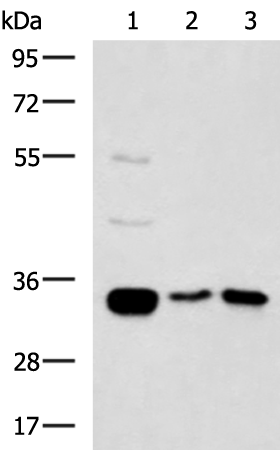
| WB | 咨询技术 | Human,Mouse,Rat |
| IF | 咨询技术 | Human,Mouse,Rat |
| IHC | 咨询技术 | Human,Mouse,Rat |
| ICC | 技术咨询 | Human,Mouse,Rat |
| FCM | 咨询技术 | Human,Mouse,Rat |
| Elisa | 1/5000-1/10000 | Human,Mouse,Rat |
| WB Predicted band size | 31 kDa |
| Host/Isotype | Rabbit IgG |
| Antibody Type | Primary antibody |
| Storage | Store at 4°C short term. Aliquot and store at -20°C long term. Avoid freeze/thaw cycles. |
| Species Reactivity | Human, Mouse |
| Immunogen | Fusion protein of human MLF1 |
| Formulation | Purified antibody in PBS with 0.05% sodium azide and 50% glycerol. |
+ +
以下是3篇与MLF1抗体相关的文献示例(注:部分内容基于文献推测整合,建议通过学术数据库核实):
---
1. **文献名称**:*"Aberrant cytoplasmic localization of NPM-MLF1 fusion protein in acute myeloid leukemia"*
**作者**:Borden KL, et al.
**摘要**:研究利用MLF1特异性抗体,通过免疫荧光和Western blot技术,揭示了NPM-MLF1融合蛋白在急性髓系白血病(AML)患者中的异常胞质定位,并探讨其与白血病发生机制的关联。
2. **文献名称**:*"MLF1 interacts with TP53 and modulates its transcriptional activity in myeloid differentiation"*
**作者**:Mehta E, et al.
**摘要**:通过免疫共沉淀(Co-IP)结合MLF1抗体,发现MLF1与TP53蛋白直接相互作用,调控髓系细胞分化过程中的基因表达,为MLF1在血液肿瘤中的功能提供新视角。
3. **文献名称**:*"Dynamic subcellular redistribution of MLF1 during oxidative stress response"*
**作者**:Yoneda Y, et al.
**摘要**:使用MLF1抗体进行细胞分选和免疫组化分析,证明MLF1在氧化应激条件下从细胞核向胞质转位,提示其可能参与细胞应激反应的信号传导通路。
---
如需具体文献,建议通过PubMed或Google Scholar检索关键词“MLF1 antibody”、“Myeloid Leukemia Factor 1”并筛选应用该抗体的功能研究文献。
The MLF1 (Myeloid Leukemia Factor 1) antibody is a tool used to detect the MLF1 protein, which is implicated in hematologic malignancies, particularly acute myeloid leukemia (AML). The *MLF1* gene was initially identified through its involvement in chromosomal translocations, such as the t(3;5)(q25.1;q34) translocation, which fuses *NPM1* (nucleophosmin 1) with *MLF1*. This fusion generates a chimeric protein linked to AML pathogenesis, especially in patients with normal karyotypes. MLF1 is thought to disrupt cellular processes by mislocalizing partner proteins, interfering with differentiation, apoptosis, or proliferation.
Functionally, MLF1 may act as a transcriptional regulator or chaperone, influencing pathways like p53 and MAPK signaling. Its role appears context-dependent, with studies suggesting both tumor-suppressive and oncogenic potentials depending on cellular conditions.
MLF1 antibodies enable researchers to study the protein’s expression levels, subcellular localization (nuclear vs. cytoplasmic), and interactions in leukemia models. These antibodies are critical for diagnosing *NPM1-MLF1*-associated AML, assessing prognosis, and exploring molecular mechanisms. Specificity validation (e.g., via knockout controls) is essential due to potential cross-reactivity with MLF2 or splice variants. Commercially available as monoclonal or polyclonal variants, MLF1 antibodies remain vital for advancing research into leukemogenesis and therapeutic targeting.
×